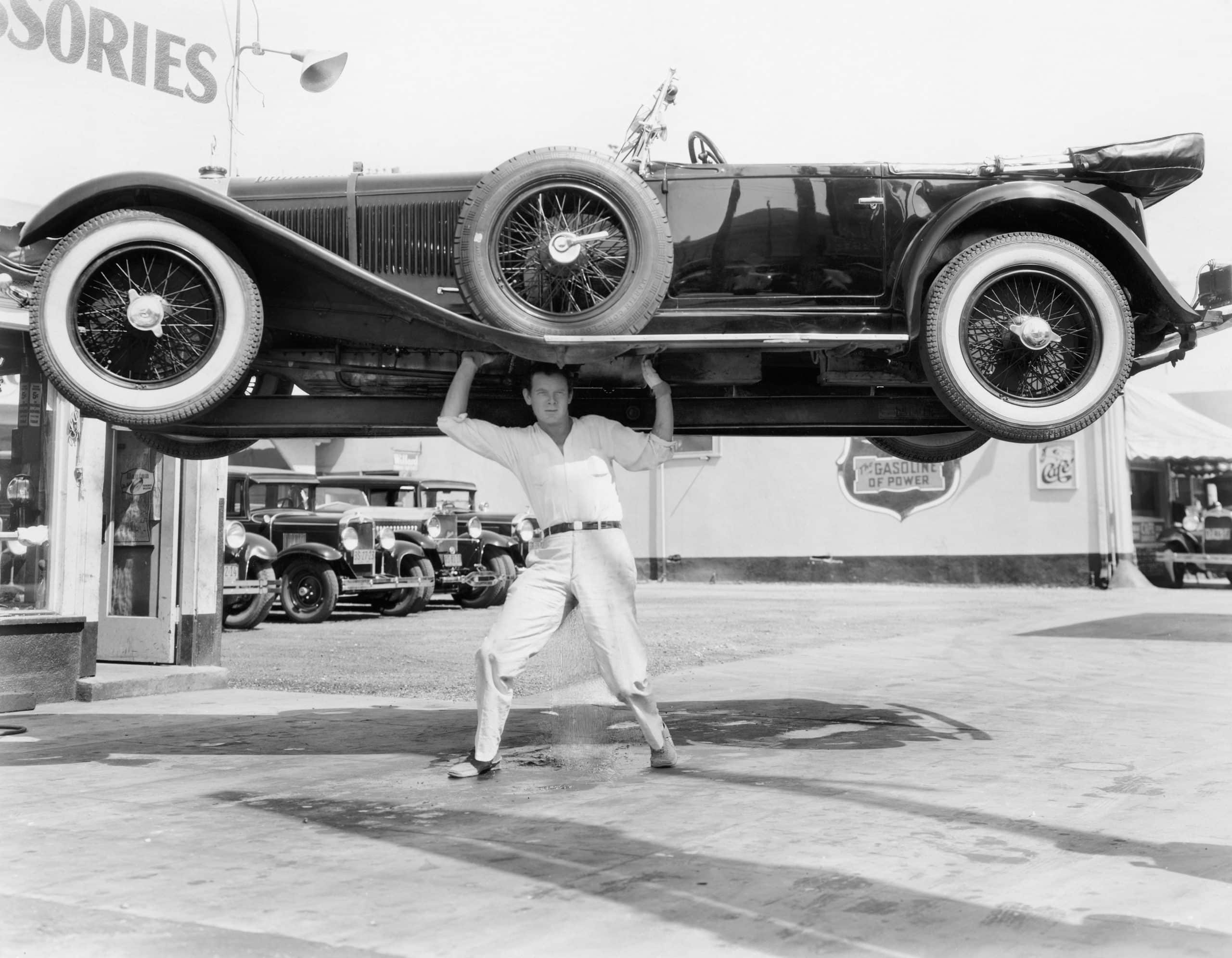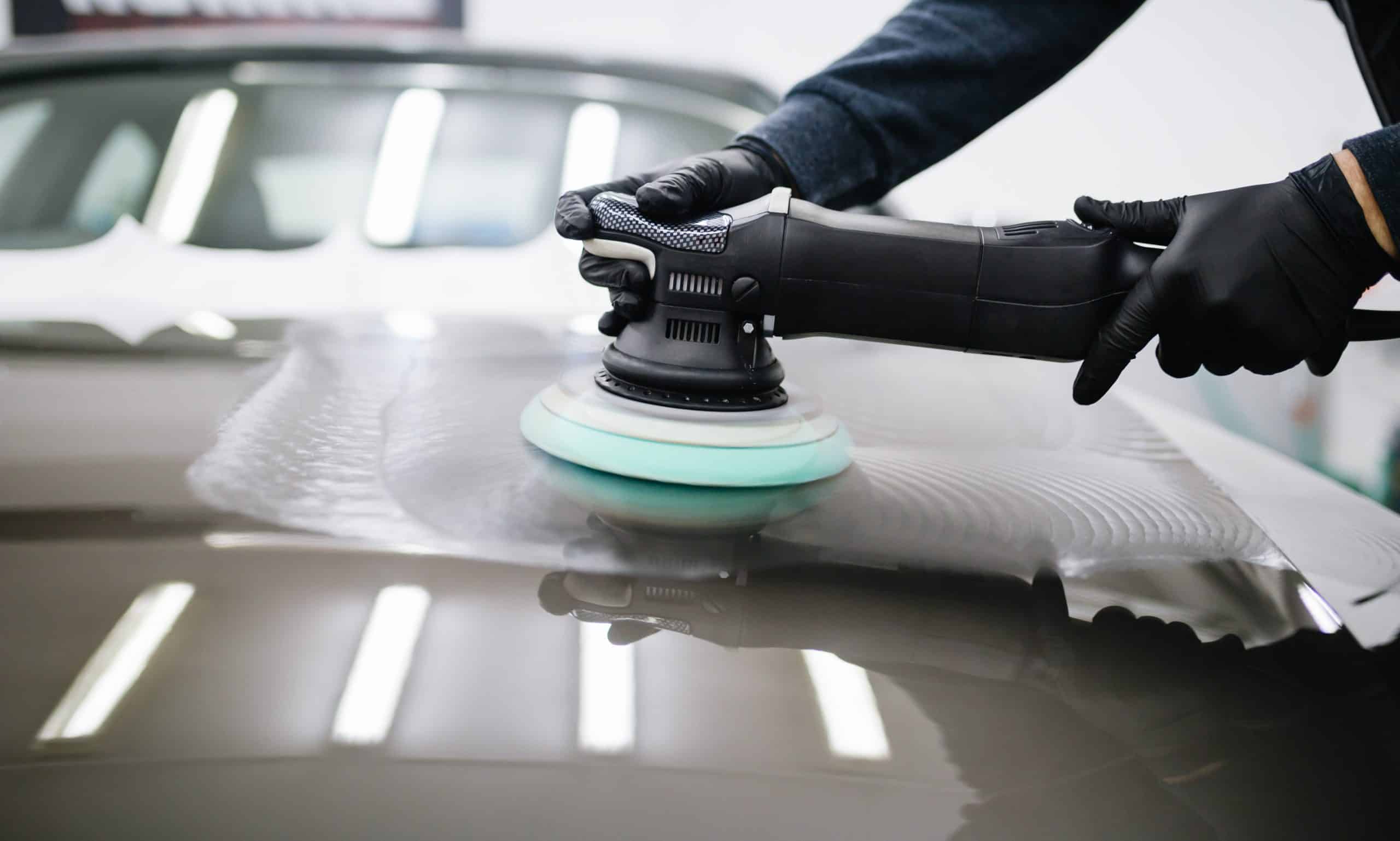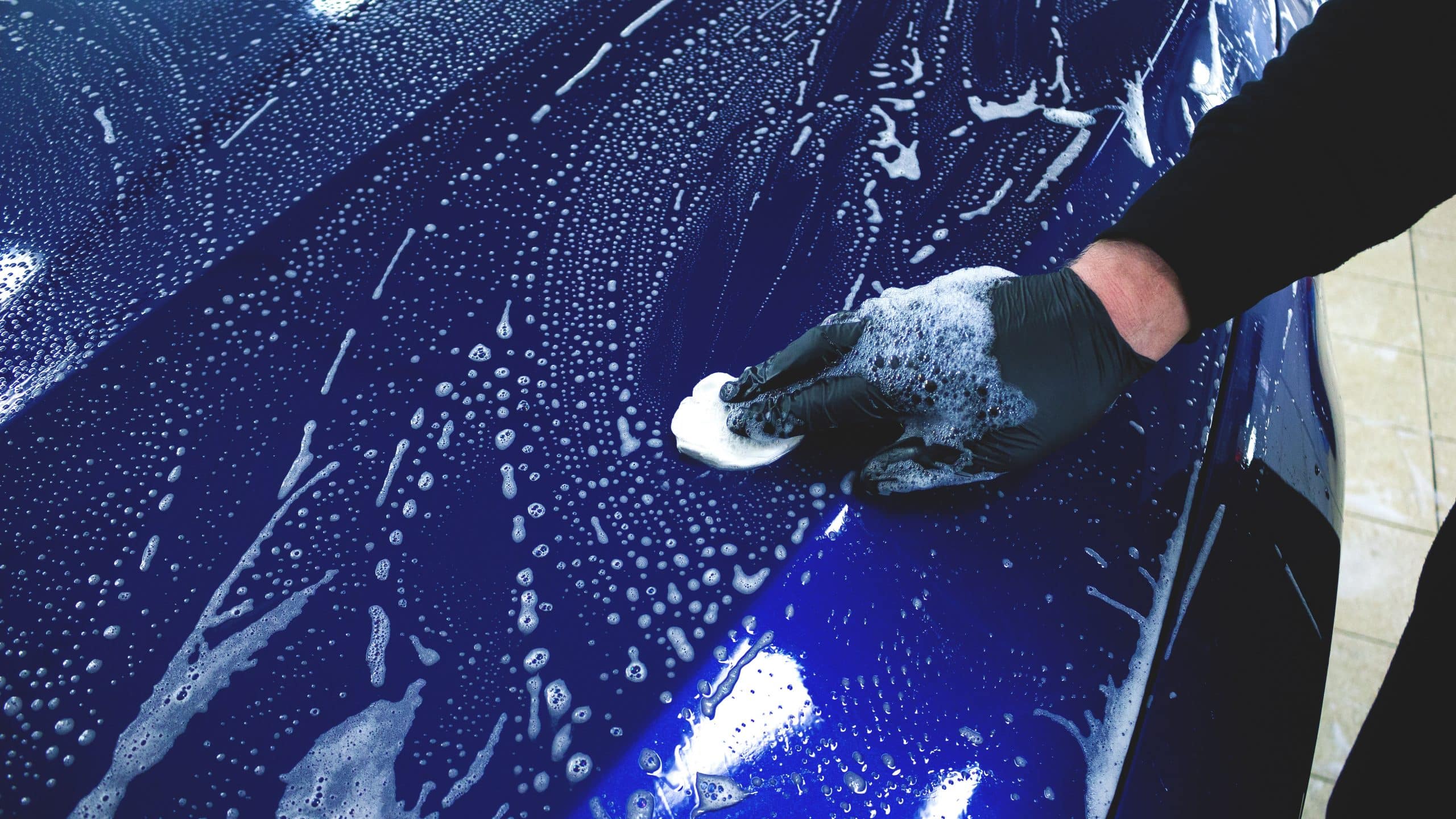
Table of Contents
Cover It With a Tarp

“Just cover it with a tarp, it’ll be just fine…”
Nope, don’t think so…
This is one of the biggest mistakes you can make when you want to protect a car from the outside elements.
The upside is that a tarp will partially protect your car from direct sunlight (UV), rainfall, bird poop, tree sap,…
The big downside is that any moisture captured underneath the tarp will have a very hard time drying and evaporating because evaporation rises with hot air.
Hot, moist air will rise to the top of the tarp and most of it will be trapped and settle there, condensing again on the inside of the tarp at night when temperatures drop.
This constant recycling of moist will be enhanced by moisture that evaporates from the soil or pavement underneath your car getting trapped under the tarp too.
This creates a constant high humidity microclimate, ideal for mildew, fungi, rot and rust.
Although the popular “tarp shelter” is one of the most dramatic examples of how not to protect your car from deterioration, many other storage solutions are also far from ideal…
In fact, many private garages, sheds and barns could do with some (or a lot of) improvement too…
That’s why following tips and ideas may also improve your storage conditions, reducing your classic’s maintenance, refurbish, respray and rebuild costs dramatically in the medium to long term.
Often with only a small budget, attention to detail and some common sense, game changing improvements can be made.
Things to Consider
There are many things to consider when parking your classic, whether it be overnight or for longer periods of time, enclosed or outdoors.
Depending on your situation and needs, following checklists can be consulted:
- Short-Term Enclosed Storage (up to 3 weeks)
- Medium-Term Enclosed Storage (3 weeks-1 year)
- Long-Term Enclosed Storage (indefinite)
- Outside Storage (short-term solution only)
- Optimized Outside Storage (short- to medium-term solution)
Storage Checklists:
Short-Term Enclosed Storage (up to 3 weeks):
Controlled storage environment (garage/container/enclosed facility):
- Sufficient insulation: slows down temperature fluctuations and keeps temperature above freezing point with minimal energy.
- Pest control: make sure to keep pests out by sealing all cracks and holes to keep out rodents, marten, chipmunks, raccoons… Put Bounce sheets in the trunk, passenger space and under the hood to deter rodents from entering and damaging your car and it will make it smell good.
- Insect control: check for and remove all insects (ants, moths, termites, spiders, flies, wasps,…) and plug in an ultrasonic indoor anti mouse, ant, mosquito and cockroach device to scare away pests.
- Stable temperature: 1°C-25°C / 33°F-77°F fluctuating no more than 5°C / 10°F per hour, controlled by a low capacity heater with no open flame set at its lowest setting.
- Relative Humidity: 40%-60% controlled by a high efficiency dehumidifier. Between 40% and 60% RH, mildew, rot and rust have no chance to develop. Below 40% RH leather will dry and crack.
- Air circulation: install a low energy, high dispersion ventilator to mix and equalize temperature and humidity between floor and ceiling. (warm air rises, cool air drops)
The best but most involved option is to install a mobile air conditioning / heating unit or a permanent split unit air conditioning / heater. In this case however, you will not need a heater, dehumidifier nor ventilator.
- Cover your car with breathable blankets or preferably a quality indoor car cover to protect the coating from dust and also from fly and spider droppings.
- Install a wifi temperature and humidity sensor with automated alerts to monitor storage conditions in case something goes wrong (a leak, dehumidifier or heater malfunction, power failure,…). Murphy never sleeps 😉
- Good overhead professional workshop lighting can make routine inspections and tinkering so much easier.
Multi-directional high light output, low energy consumption and easy to install.
Make sure you have the right length of switched lamp cable and adhesive cable clips or a lamp socket to connect to existing wiring.
Preventive Measures:
- Make sure all electrics and ignition key are switched off, switch off the battery kill switch if installed.
- Keep your car battery in top shape with an intelligent battery trainer.
- Put one or two drip trays underneath your car to catch inevitable oil spills.
Medium-Term Enclosed Storage (3 weeks-1 year):
Controlled environment (garage/container/enclosed facility):
- Sufficient insulation: slows down temperature fluctuations and keeps temperature above freezing point with minimal energy.
- Pest control: make sure to keep pests out by sealing all cracks and holes to keep out rodents, marten, chipmunks, raccoons… Put Bounce sheets in the trunk, passenger space and under the hood to deter rodents from entering and damaging your car and it will make it smell good.
- Insect control: check for and remove all insects (ants, moths, termites, spiders, flies, wasps,…) and plug in an ultrasonic indoor anti mouse, ant, mosquito and cockroach device to scare away pests.
- Stable temperature: 1°C-25°C / 33°F-77°F fluctuating no more than 5°C / 10°F per hour, controlled by a low capacity heater with no open flame set at its lowest setting.
- Relative Humidity: 40%-60% controlled by a high efficiency dehumidifier. Between 40% and 60% RH, mildew, rot and rust have no chance to develop. Below 40% RH leather will dry and crack.
- Air circulation: install a low energy, high dispersion ventilator to mix and equalize temperature and humidity between floor and ceiling. (warm air rises, cool air drops)
The best but most involved option is to install a mobile air conditioning / heating unit or a permanent split unit air conditioning / heater. In this case you will not need a heater, dehumidifier or ventilator.
- Cover your car with a breathable blanket or preferably a quality indoor car cover.
- Install a wifi temperature and humidity sensor with automated alerts to monitor storage conditions in case something goes wrong (a leak, dehumidifier or heater malfunction, power failure,…). Murphy never sleeps 😉
- Good overhead professional workshop lighting can make routine inspections and tinkering so much easier.
Multi-directional led high light output, low energy consumption and easy to install.
Make sure you have the right length of switched lamp cable and adhesive cable clips or a lamp socket to connect to existing wiring.
Preventive Measures:
- Clean the car thoroughly (check out “How To Wash Your Car”) and if the car has been used in winter rinse the underside with preferably lukewarm water to rinse off possible salt deposits. The underside of the car should only be cleaned with water if it has time to dry in warm and dry conditions. Otherwise don’t use water.
- Drain about one liter of fuel from the fuel tank drain plug to make sure all water from condensation that settled on the bottom of the fuel tank (=heavier than fuel) is gone to prevent the bottom of the fuel tank from rusting through, then add fuel stabilizer and top off with fresh fuel. Let the engine idle for a few minutes until the fuel stabilizer has reached the carburettors.
- Make sure all electrics and the ignition key are switched off, switch off the battery kill switch if installed.
- Keep your car battery in top shape with an intelligent battery trainer.
- Put one or two drip trays underneath your car to catch inevitable oil spills.
- Inflate tires close to maximum pressure and put them on tyre savers to prevent deforming and flat spots.
- Change the engine oil and oil filter to prevent acid and water corrosion of engine internals by polluted engine oil.
- Replace the engine coolant with “Evans Classic Cool” or check antifreeze mixture in engine coolant; change coolant if necessary or older than 2 years. Fresh coolant with antifreeze contains corrosion inhibitors which prevent internal corrosion of the engine.
- Replace spark plugs by desiccant plugs to prevent cylinder corrosion because of condensation.
- Don’t use the parking brake, it might stick or seize.
TIP: Although it is recommended to exercise your stored car every few weeks (don’t forget to switch the desiccant plugs if fitted), you have to drive it for at least 10 miles / 15 km each time or not start it up at all.
Research has shown most engine wear occurs at startup when little or no lubricants are present to protect the cold engine, especially at the top end, so you will do more harm than good.
If you are not willing or able to exercise your car (e.g. because of weather conditions), it’s better to build up oil pressure with the plugs removed using the starter motor only (can’t start + less resistance for the starter engine). Keep an eye on the oil pressure gauge: keep cranking your starter motor for about 15 seconds after oil pressure has built up so lubricants can reach the top of the engine. This way the engine turns much slower with less resistance and less wear as a result, yet lubricating all internals.
>The other option is to not run it at all but to prepare your car for “Long Term Enclosed Storage”.
Long-Term Enclosed Storage (indefinite):
Controlled environment (garage/container/enclosed facility):
- Sufficient insulation: slows down temperature fluctuations and keeps temperature above freezing point with minimal energy.
- Pest control: make sure to keep pests out by sealing all cracks and holes to keep out rodents, marten, chipmunks, raccoons… Put Bounce sheets in the trunk, passenger space and under the hood to deter rodents from entering and damaging your car and it will make it smell good.
- Insect control: check for and remove all insects (ants, moths, termites, spiders, flies, wasps,…) and plug in an ultrasonic indoor anti mouse, ant, mosquito and cockroach device to scare away pests.
- Stable temperature: 1°C-25°C / 33°F-77°F fluctuating no more than 5°C / 10°F per hour, controlled by a low capacity heater with no open flame set at its lowest setting. This will prevent condensation on the inside of the car body panels.
- Relative Humidity: 40%-60% controlled by a high efficiency dehumidifier. Between 40% and 60% RH, mildew, rot and rust have no chance to develop. Below 40% RH leather will dry and crack.
- Air circulation: install a low energy, high dispersion ventilator to mix and equalize temperature and humidity between floor and ceiling. (warm air rises, cool air drops)
The best but most involved option is to install a mobile air conditioning / heating unit or a permanent split unit air conditioning / heater. In this case you will not need a heater, dehumidifier nor ventilator.
- Cover your car with a breathable blanket or preferably a quality indoor car cover.
- Install a wifi temperature and humidity sensor with automated alerts to monitor storage conditions in case something goes wrong (a leak, dehumidifier or heater malfunction, power failure,…). Murphy never sleeps 😉
- Good overhead professional workshop lighting can make routine inspections and tinkering so much easier.
Multi-directional high light output, low energy consumption and easy to install.
Make sure you have the right length of switched lamp cable and adhesive cable clips or a lamp socket to connect to existing wiring.
Preventive Measures:
- Clean the car thoroughly (check out “How To Wash Your Car”) and if the car has been used in winter rinse the underside with preferably lukewarm water to rinse off possible salt deposits. The underside of the car should only be cleaned with water if it has time to dry in warm and dry conditions. Otherwise don’t use water.
- Nourish the interior leather with Leather Honey to prevent drying and cracking.
- Drain the fuel tank and put a nylon sock with silica gel in the filler neck to dry it out and stop corrosion on the inside. Put an airtight seal over the filler neck to prevent moisture from creeping in.
- Remove the car battery from the car and keep it in top shape with an intelligent battery trainer while stored.
- Put your car on jack stands to take the load off the tires.
- Grease all grease nipples to prevent corrosion from old, water polluted grease.
- Put one or two drip trays underneath your car to catch inevitable oil spills.
- Change the engine oil and oil filter to prevent acid and water corrosion of engine internals by polluted engine oil.
- Replace the engine coolant with “Evans Classic Cool” which is non-corrosive and does not degrade over time.
- Coat the engine internals with “fogging oil”: Start the engine, adjust the throttle to keep the engine from stalling as you spray the fogging oil into the carburettor(s). When thick, blue smoke begins billowing out of the exhaust, idle down and keep spraying fogging oil into the air intake until the engine stalls.
- Remove the spark plugs and spray fogging oil into each cylinder via the spark plug holes. Crank the engine a couple of cycles by hand or starter to circulate the fogging oil.
- Replace the spark plugs by desiccant plugs to prevent cylinder wall corrosion because of condensation.
- Cover the air filter(s) with an airtight seal to prevent moisture and dust coming in. It will also keep the fogging oil’s volatile substances in the carbs from evaporating and drying over time.
- Change the transmission and back axle oil.
- Change the brake fluid. While in storage, pump the brake pedal several times at least every few months to prevent the brakes from seizing. When in dry storage (40-60% RH) it is best to change the brake fluid at least every 3-5 years.
- Don’t use the parking brake, it might stick or seize.
IMPORTANT NOTICE: Check on your car at least every month, or every three months even if you have a wifi temperature and humidity sensor with automated alerts installed to make sure everything is still as it should. If not: correct it immediately.
You would not want to open your storage after a couple of years to find a water leak or rodents have wreaked havoc on your prized belonging.
Optimized Outside Storage (short- to medium-term solution):
- Put up a car shelter suitable for your car size + approx. 2 feet on all sides for you to maneuver around your car and open the driver’s door wide enough to get in and out. The shelter should also preferably be around 4ft / 1.2m longer than your car to house a high efficiency dehumidifier with a low capacity heater with no open flame or a mobile air conditioning / heating unit. Make sure the sides of the shelter can’t touch your car under heavy winds.
NOTE: A large shelter will consume more energy to dehumidify and defrost than a small one.
CAUTION: Position your car shelter wisely:
- Choose the highest ground on your property (humidity/flooding).
- A spot under a healthy, sturdy tree(s) without heavy dead branches can provide shade and hail protection but very high trees have a higher risk of lightning strikes.
- Choose a spot away from low shrubs or high grass: you don’t want to attract critters.
- The closer to the main house the better (easier power supply / easier to check / wifi availability for monitoring / habitation scares many critters).
- Downwind behind a building is the safest spot in case of a storm depending on your location.
- Avoid a spot in full sunlight to avoid excessive air conditioning bills or extreme inside temperatures.
- Examine the surroundings for unwanted ant’s nests, rat/mice habitation,… and take preventive measures if necessary.
- Make sure the area around your car shelter is always mowed and/or clean for easy inspection and to deter critters.
- Cover the entire shelter floor with an all weather floor mat with a water barrier or an oversized tarp with the edges folded upright, leaning against the inside of the shelter. This creates a water barrier so with heavy rainfall water won’t flow over the floor mat. Make sure the corners of the floor mat are also folded inwards. The floor cover will prevent moisture rising up under your car.
- Clean the exterior of your car (check out “How To Wash Your Car”) to prevent dirt and other contaminants like acid and chemicals from bird droppings, insect remains, rain, salt spray,… from attacking your car’s paint and causing rust. It also prevents your car cover from getting dirty on the inside and scratching your car’s paint.
- Clean the interior of your car to prevent mildew and bad odour. Tried, tested and highly recommended: Leather Honey for leather trim and Adam’s Total Interior Cleaner for everything else.
- Put Bounce sheets in the trunk, passenger space and under the hood to deter rodents from entering and damaging your car and it will make it smell good.
- Close the soft top or preferably put on a hard top.
- Put silica gel desiccant bags inside the passenger compartment and trunk to keep inside humidity low and prevent mildew and bad odour.
- Make sure the windows, doors and the trunk are closed firmly to keep moisture and critters out.
- Cover your car with an indoor car cover.
- Plug in an ultrasonic indoor anti mouse, ant, mosquito and cockroach device to scare away pests.
- Install a low capacity heater with no open flame set at its lowest setting combined with a high efficiency dehumidifier set at 40%-60% relative humidity. Between 40% and 60% RH, mildew, rot and rust have no chance to develop. Below 40% RH leather will dry and crack.
- Air circulation: install a low energy, high dispersion ventilator to mix and equalize temperature and humidity between floor and ceiling (warm air rises, cool air drops) and prevent condensation.
The other option is to install a mobile air conditioning / heating unit. In this case you will not need a heater, dehumidifier or ventilator.
- Inflate tires close to maximum pressure to minimize the risk of flat spots.
- Top off your gas tank to minimize internal condensation.
- Check your coolant for sufficient antifreeze. Replace if needed.
- Make sure there are no food leftovers, crumbs or empty food wraps left in your car because this will attract critters and stimulate mould growth.
- Do not use your parking brake. It might stick or freeze. Use wheel chocks instead.
- Install an intelligent battery trainer or charge and then disconnect the car battery.
- Connect all your appliances to a surge protector power strip, plugged into an outdoor extension cord. Tidy up any excess power cord with reusable cable ties. Make sure all cable connections are safely off the ground.
- Install a wifi temperature and humidity sensor with automated alerts to monitor storage conditions in case something goes wrong (a leak, dehumidifier or heater malfunction, power failure,…). Murphy never sleeps 😉
- Good overhead professional workshop lighting can make routine inspections and tinkering so much easier.
Multi-directional high light output, low energy consumption and easy to install.
Make sure you have the right length of switched lamp cable and adhesive cable clips or a lamp socket to connect to existing wiring.
Outside Storage (short-term solution only):
- Clean the exterior of your car (check out “How To Wash Your Car”) to prevent dirt and other contaminants like acid and chemicals from bird droppings, insect remains, rain, salt spray,… from attacking your car’s paint and causing rust. It also prevents your car cover from getting dirty on the inside and scratching your car’s paint.
- Clean the interior of your car to prevent mildew and bad odour. Tried, tested and highly recommended: Leather Honey for leather trim and Adam’s Total Interior Cleaner for everything else.
- Put Bounce sheets in the trunk, passenger space and under the hood to deter rodents from entering and damaging your car and it will make it smell good.
- Close the soft top or preferably put on a hard top.
- Put your car on a heavy duty tarp to prevent soil or pavement humidity from rising and condensing underneath your car. Make sure water does not collect on the tarp, but runs off easily. Secure it on all sides with pegs or weights.
- Put silica gel desiccant bags inside the passenger compartment and trunk to keep inside humidity low and prevent mildew and bad odour.
- Make sure windows, doors and trunk are closed firmly to keep moisture and critters out.
- Put a breathable outdoor car cover over your car to protect it from the elements.
- Inflate tires close to maximum pressure to minimize the risk of flat spots.
- Top off your gas tank to minimize internal condensation.
- Check your coolant for sufficient antifreeze. Replace if needed.
- Make sure there are no food leftovers, crumbs or empty food wraps left in your car because this will attract critters and stimulate mould growth.
- Do not use your parking brake. It might stick or freeze. Use wheel chocks instead.
- Install an intelligent battery trainer or charge and then disconnect the car battery.
Final Thoughts
Many cars die in their sleep, so to speak…
Most people are scared to use their beautiful classic and tuck it away in a barn or under a tarp in the driveway to “preserve” it. This has the potential for disaster…
When they return to their pride and joy to go for a sunday spring drive after many cold, wet winter months of unattended hibernation, chances are it is in much worse condition than when they left it.
It may not start, have a flat tire, it may have developed corrosion or mold and the brakes may have frozen or may not work. There may be mice nests under the bonnet, cobwebs inside, electrics may act up…
How is this possible? It was stored in a safe place out of the rain, right?
Hate to burst that bubble, but storing a classic car “out of the rain” is not nearly enough if you want to keep it in pristine condition. Just parking it under a carport, tarp or even in a shed or garage doesn’t make you a good keeper… at all…
There’s a lot more to consider depending on how long you want to store it. It’s not all about “where” but also “how” you store it. It’s all about which precautions and preparations you’ve taken to minimize decay.
You have to understand that for a classic car, the sum of “abuse” or “mistreatment” adds up over the years. It doesn’t rust overnight, nor do the brakes seize all at once, the engine isn’t corroded internally by old corrosive oil or coolant in one week… It’s a slow creeping process over time. And finally it will catch up on you and cost you dearly.
Each night you store it in humid conditions, each time you drive it on salty roads without washing it off thoroughly, each postponed maintenance,… it all adds up.
However, no abuse is more repetitive and harmful than bad storage. It’s reoccurring, relentless… Bad storage eats away at your classic each and every night and day.
It’s the most important and probably the most misunderstood cause of general deterioration.
It should by no means be underestimated.
All right, we’ve talked about the “bad” and the “ugly”, let’s talk about the “good” news:
The good news is that each penny you invest in improving the “living conditions” of your pride and joy will be greatly rewarded in less costs for bodywork, mechanics and maintenance in general. Most importantly it will perform much more reliably with lesser breakdowns.
Here’s a summary of the checklists in order to create different ideal storing solutions with minimal costs for your situation within your budget:
- Short-Term Enclosed Storage (up to 3 weeks)
- Medium-Term Enclosed Storage (3 weeks-1 year)
- Long-Term Enclosed Storage (indefinite)
- Outside Storage (short-term solution only)
- Optimized Outside Storage (short- to medium-term solution)
Happy cruisin’!







